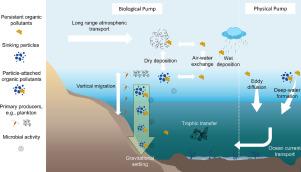Water Research ( IF 11.4 ) Pub Date : 2021-09-11 , DOI: 10.1016/j.watres.2021.117658 Edmond Sanganyado 1 , Kudakwashe E Chingono 2 , Willis Gwenzi 3 , Nhamo Chaukura 4 , Wenhua Liu 1

|
The deep sea - an oceanic layer below 200 m depths – has important global biogeochemical and nutrient cycling functions. It also receives organic pollutants from anthropogenic sources, which threatens the ecological function of the deep sea. In this Review, critically examined data on the distribution of organic pollutants in the deep sea to outline the role of biogeochemical and geophysical factors on the global distribution and regional chemodynamics of organic pollutants in the deep sea. We found that the contribution of deep water formation to the influx of perfluorinated compounds reached a maximum, following peak emission, faster in young deep waters (< 10 years) compared to older deep waters (> 100 years). For example, perfluorinated compounds had low concentrations (< 10 pg L−1) and vertical variations in the South Pacific Ocean where the ocean currents are old (< 1000 years). Steep geomorphologies of submarine canyons, ridges, and valleys facilitated the transport of sediments and associated organic pollutants by oceanic currents from the continental shelf to remote deep seas. In addition, we found that, even though an estimated 1.2–4.2 million metric tons of plastic debris enter the ocean through riverine discharge annually, the role of microplastics as vectors of organic pollutants (e.g., plastic monomers, additives, and attached organic pollutants) in the deep sea is often overlooked. Finally, we recommend assessing the biological effects of organic pollutants in deep sea biota, large-scale monitoring of organic pollutants, reconstructing historical emissions using sediment cores, and assessing the impact of deep-sea mining on the ecosystem.
中文翻译:

深海有机污染物:发生、归宿和生态影响
深海——深度低于 200 米的海洋层——具有重要的全球生物地球化学和营养循环功能。它还接收来自人为来源的有机污染物,这威胁到深海的生态功能。在这篇综述中,批判性地检查了深海有机污染物分布的数据,以概述生物地球化学和地球物理因素对深海有机污染物的全球分布和区域化学动力学的作用。我们发现,与较老的深水(> 100 年)相比,深水形成对全氟化合物流入的贡献在达到峰值后,在年轻的深水(< 10 年)中更快。例如,全氟化合物的浓度较低(< 10 pg L -1) 和南太平洋的垂直变化,那里洋流很老(< 1000 年)。海底峡谷、山脊和山谷的陡峭地貌促进了洋流将沉积物和相关有机污染物从大陆架输送到偏远的深海。此外,我们发现,尽管每年估计有 1.2-420 万吨塑料碎片通过河流排放进入海洋,但微塑料作为有机污染物(例如、塑料单体、添加剂和附着的有机污染物)在深海中经常被忽视。最后,我们建议评估深海生物群中有机污染物的生物效应,大规模监测有机污染物,使用沉积物核心重建历史排放,评估深海采矿对生态系统的影响。











































 京公网安备 11010802027423号
京公网安备 11010802027423号